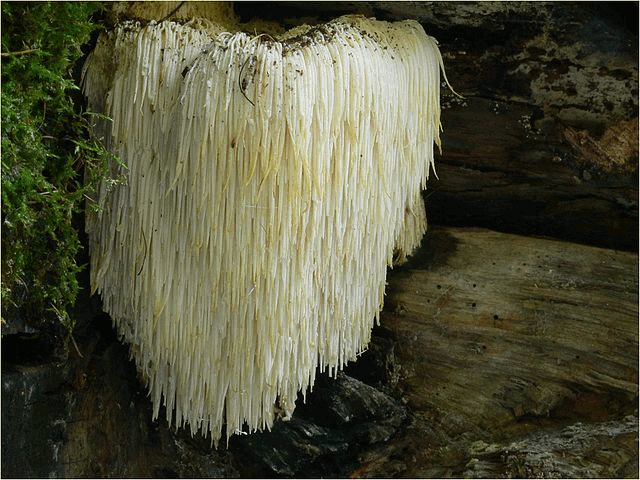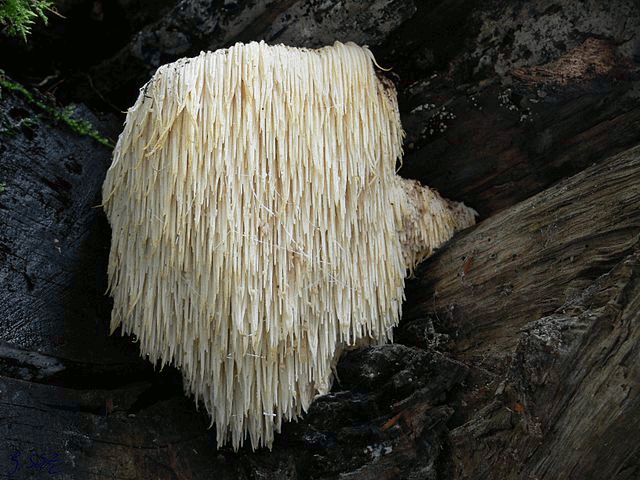Lion's Mane Mushroom
 Common Names: lion’s mane mushroom, hedgehog mushroom, satyr’s beard mushroom, yamabushitake, bearded tooth mushroom or fungus.
Common Names: lion’s mane mushroom, hedgehog mushroom, satyr’s beard mushroom, yamabushitake, bearded tooth mushroom or fungus.
Scientific Name: Hericium Erinaceus
Climate: cold and moderate
Plant Description: This is a white, parasitic fungus that grows from recently cut trees. It is 8-16 cm in diameter. It is distinctive because it is the only species that grows in a single clump of dangling spines from one hard base, as opposed to spines hanging from a branched structure. The spines are about one centimeter long. These mushrooms usually grow alone or in pairs.
Cultivation: Lion’s Mane can be cultivated extensively or intensively. For extensive cultivation, logs are spawned with wood fragments which contain mycelium of the mushroom. The spawning logs are then placed in conditions with high humidity. Spawning happens naturally and fruitbodies take several months to appear. Although this method is simple and cheap, production takes a long time.
For bigger harvests, intensive cultivation must be used. This usually happens in bottles or plastic bags. The substrates need to be sterilized and the bottles must be made from materials that can resist heat. Bottles and bags must have a filter so that the mycelium can breathe when it is spawning. Production with bags is cheaper but the fruitbodies are smaller than those grown in bottles.
Lion’s Mane grows naturally on oak, maple, birch and pine trees, so the substrate made from woodchip from these trees produces good yields. The substrate can be made from a mix of corn cobs, wheat bran and a small amount of sugar (about 1% to ensure good mycelium growth). It may be cultivated on sterilized sawdust with cereal bran.
Once the mushroom has fully grown, it can be harvested between four and seven days after the pins have appeared and this should occur before it turns brown. They can be refrigerated for up to two weeks or dried.
 Uses: Lion’s mane is a tasty mushroom that can be cooked in a number of ways. It has a strong taste of seafood and is often used as a substitute in many such dishes. It is an excellent substitute for crab in vegetarian dishes.
Uses: Lion’s mane is a tasty mushroom that can be cooked in a number of ways. It has a strong taste of seafood and is often used as a substitute in many such dishes. It is an excellent substitute for crab in vegetarian dishes.
This mushroom has anti-inflammatory effects and also acts as an antioxidant. These qualities may help to reduce the effects of chronic illnesses such as heart disease and certain cancers. There are indications that it may have restorative and generative effects on brain cells which may help in recovery from neural damage and slow dementia. As an anti-inflammatory, it may also protect against ulcers. There are indications that the mushroom reduces levels of blood sugars, which could be useful for treating diabetes.
There is evidence that lion’s mane increases the activity of the intestinal immune system, which protects the body from pathogens that enter the body through the nose and mouth. It may help to boost the immune system and protect us from bacteria and viruses.
Possible Problems: If you are using logs to grow the mushroom, it is important that these are dried for about two months so that they have about 40% humidity. They should not be kept with firewood to avoid pests and diseases. If the logs develop mould, they need to be moved around to ensure better air circulation. If they become too infested, they need to be replaced. Likewise, the logs can become too dry. If this is the case, they should be sprayed with water.
When grown in bags or bottles, it is essential that these should have a filter to prevent other fungi and bacteria growing inside the receptacles.
References:
http://www.medicalmushrooms.net/hericium-erinaceus/
https://www.mushroomexpert.com/hericium_erinaceus.html
https://pbsociety.org.pl/journals/index.php/am/article/view/am.1069/5775
https://morningchores.com/growing-lions-mane-mushrooms/
En español: Melena de león
